
The Buxales are a small order of eudicot flowering plants, recognized by the APG IV system of 2016. The order includes the family Buxaceae; the families Didymelaceae and Haptanthaceae may also be recognized or may be included in the Buxaceae. Many members of the order are evergreen shrubs or trees, although some are herbaceous perennials. They have separate "male" (staminate) and "female" (carpellate) flowers, mostly on the same plant. Some species are of economic importance either for the wood they produce or as ornamental plants.
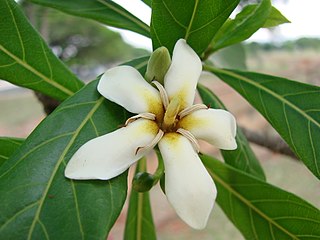
Genipa americana is a species of trees in the family Rubiaceae. It is native to the tropical forests of North and South America, as well as the Caribbean.
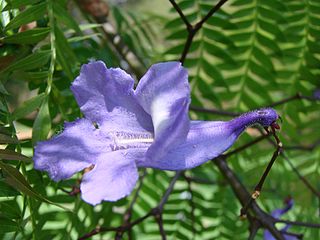
Jacaranda is a genus of 49 species of flowering plants in the family Bignoniaceae, native to tropical and subtropical regions of the Americas. It can also be found in South Africa. The generic name is also used as the common name.
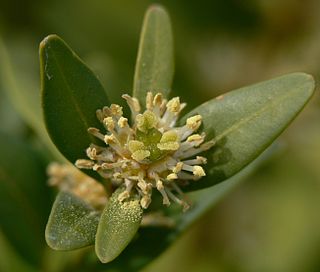
The Buxaceae are a small family of six genera and about 123 known species of flowering plants. They are shrubs and small trees, with a cosmopolitan distribution. A seventh genus, sometimes accepted in the past (Notobuxus), has been shown by genetic studies to be included within Buxus.

Virola is a genus of medium-sized trees native to the South American rainforest and closely related to other Myristicaceae, such as nutmeg. Species are known commonly as epená, patricá, or cumala. They have glossy, dark green leaves and clusters of tiny yellow flowers, and may emit a pungent odor.

Haptanthus is a monotypic genus containing the sole species Haptanthus hazlettii, a shrub or small tree known only from the locality of Matarras in the Arizona Municipality in Honduras. Its flowers are unique among the flowering plants. A single "female" (carpellate) flower has two branches on either side which carry "male" (staminate) flowers. The flowers are very simple, lacking obvious sepals or petals. The family placement of the genus has been uncertain, but based on molecular phylogenetic research, it is included in the family Buxaceae as of September 2014. Very few individuals have ever been found and its habitat is threatened by logging.

Crescentia cujete, commonly known as the calabash tree, is a species of flowering plant native to the Americas, that is grown in Africa, Central America, South America, the West Indies and extreme southern Florida. It is the national tree of St. Lucia. It is a dicotyledonous plant with simple leaves, which are alternate or in fascicles (clusters) on short shoots. It is naturalized in India. The tree shares its common name with that of the vine calabash, or bottle gourd.
Wettinia is a palm genus, consisting of flowering plants in the family Arecaceae. The genus, established in 1837, contains some 20 species, but more seem to await discovery considering that 4 species - W. aequatorialis, W. lanata, W. minima and W. panamensis - were described as late as 1995. The genus is broadly divided into two groups. One group has the fruits tightly packed, while the other, formerly classified as genus Catoblastus, has fruits scattered along the inflorescence branches. It is not known whether these groups are both monophyletic. The genus is named after Frederick Augustus II of Saxony, of the House of Wettin.
Wettinia longipetala is a species of tree in the family Arecaceae. It is found only in Peru, and is considered a vulnerable species by the IUCN.
Allomarkgrafia is a genus of flowering plants in the family Apocynaceae, first described as a genus in 1932. It is native to Central America and northwestern South America.
Buxus obtusifolia is a species of plant in the family Buxaceae. It is found in Kenya and Tanzania.
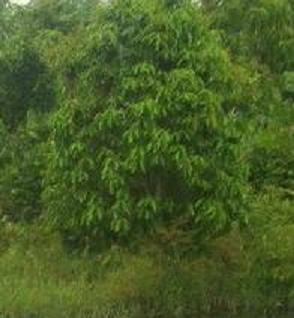
Caryodaphnopsis is a genus of 16 species belonging to the flowering plant family Lauraceae, distributed in tropical areas in southern North America, northern South America, and East and Southeast Asia.

Styloceras kunthianum is a species of plant in the family Buxaceae. It is endemic to Ecuador. Its natural habitat is subtropical or tropical moist montane forest. It is threatened by habitat loss.
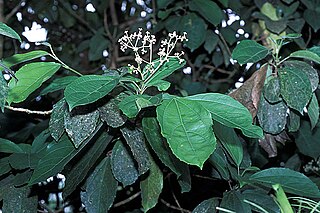
Hasseltia is a genus of flowering plants in the family Salicaceae. It contains four species of small to medium-sized trees native to the neotropics, ranging from Mexico south to Brazil and Bolivia. The genus is named for the Dutch physician and botanist Johan Conrad van Hasselt.

Alwyn Howard Gentry was an American botanist and plant collector, who made major contributions to the understanding of the vegetation of tropical forests.

Mansoa is a genus of tropical, flowering vines in the family Bignoniaceae.
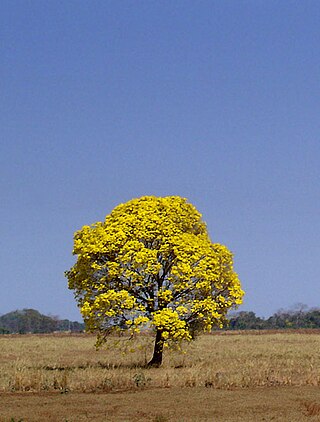
Handroanthus is a genus of flowering plants in the family Bignoniaceae. It consists of 30 species of trees, known in Latin America by the common names poui, pau d'arco, or ipê. The latter sometimes appears as epay or simply ipe (unaccented) in English. The large timber species are sometimes called lapacho or guayacan, but these names are more properly applied to the species Handroanthus lapacho and Handroanthus guayacan, respectively.
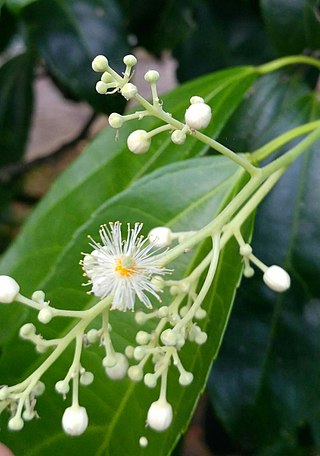
Pleuranthodendron is a genus of flowering plants in the family Salicaceae. It consists of one species of small to medium-sized trees native to the neotropics, specifically Central America and northern South America.

Poraqueiba sericea is a species of tree in the family Metteniusaceae. It is native to South America.
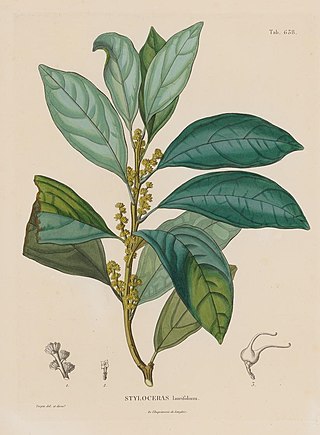
Styloceras laurifolium is a species of tree in the family Buxaceae. It is found in South America.
















